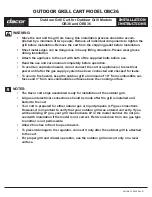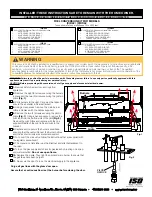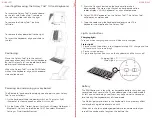
Installation Guide
ZON ZMP-3 Doorbell Module
Installing the ZMP-3 Expansion Module
1. Disconnect the AC power cord from the ZON router. WARNING! Installing any expansion module with the power
connected will damage the module, the ZR-98 (or both) and voids your product warranty.
2. Remove an expansion bay cover plate on the ZON router. Using a #2 Phillips screwdriver, remove the cover screw and
remove the cover plate.
3. Connect the 40-pin ribbon cable to the module. The cable provided with the module is the proper length type for the
ZON system. The cable is “keyed” to allow proper pin placement.
4. Connect the other end of the ribbon cable to the router, making sure the key on the cable is aligned with the key slot on
the router’s expansion bay connector.
5. Insert the module into the router. Align the tab on the module’s top with the tab opening on the router’s frame. Slide the
module in and up. This should hold the module in place.
6. Re-install the screw removed in step 1 above. When the module is properly installed, the screw hole on the bottom tab
of the module will be aligned with the threaded hole on the router’s frame.
7. It is recommended that you not re-connect power to the ZON router until after you have prepared your SD Card and
completed your trigger connections. Instructions for doing so are below.
The ZON ZMP-3 Doorbell module enables triggering of custom audio for doorbells, driveway sensors, motion detectors and other similar devices. The custom
audio, when triggered, is routed to the ZON system’s page bus, which plays back at the default paging volume of connected ZON Audio Controller Amplifiers
(controllers). Only one ZMP-3 per system is required.
Custom audio (in the form of MP3 files) is stored on an SD Card (not included). The length of the audio file(s) is determined only by the size of the SD card
used. A maximum of five MP3 files can be stored on the SD Card at one time.
Triggering of the audio is accomplished by two-conductor, dry contact closures. A phoenix-type connector (provided with each module) is integrated onboard
the ZMP-3 module.
For the latest information about the ZMP-3, check our website: http://www.zonaudio.com.
Working with SD Cards for the ZMP-3
You will need an SD Card, an SD Card Reader/Writer and software (needed for creating and editing audio files).
Any capacity SD card will work with the ZMP-3 module. Formatting the SD Card is not normally required as these cards are pre-formatted by the
manufacturer.
If your computer is not equipped with an SD Card reader port, you will need additional hardware to be able to connect your SD card. One such device is the
SanDisk Mobile Mate™ SD+. Check with your local computer hardware supplier for pricing and availability.
There are numerous freeware programs available that will help you create, edit and convert audio files to MP3 format. Audacity, a free program, is available
from http://audacity.sourceforge.net. ZON provides a free utility that will check file compatibility and naming. You can download this file from our website:
http://www.zonaudio.com/support/files.
Up to five MP3 files can be stored on a properly formatted SD card. The naming convention for these files must be as follows:
1.mp3, 2.mp3, 3.mp3, 4.mp3 and 5.mp3. “Trigger 1” corresponds to 1.mp3, “Trigger 2” corresponds to 2.mp3 and so on.
File names other than these, or saving additional files other than these on the card will result in the ZMP-3 not being able to recognize the contents of the card.
Audio file formats other than MP3 cannot be processed by the ZMP-3 module.
Note: There is a default doorbell sound that will play if no SD Card is inserted.
Figure 1
Installing Contact Closure Triggers
1. For ease of installation, remove the phoenix-type connector from the module.
2. Figure 2 shows a typical contact closure connection. With the screw terminals to your left, Trigger 1 is at
the bottom, and Trigger 5 is at the top. Each of the five triggers have a positive and a negative (or ground)
connection.
Note: The trigger contacts are for “Dry” contacts only. There must be no voltage presented by the device
which triggers the ZMP-3. Do not trigger other devices with the same ZMP-3 trigger.
3. Connect your contact closure wires for each trigger to the phoenix-type connector. You will need a small
screwdriver to open and close the wire traps in the connector. For proper operation, do not ground the
“ground terminal” of contact input externally.
4. Re-connect the phoenix-type connector to the ZMP-3 Module.
�
�
�
�
�
�
�
�
�
�
���������
���������
���������
���������
���������
Figure 2




















